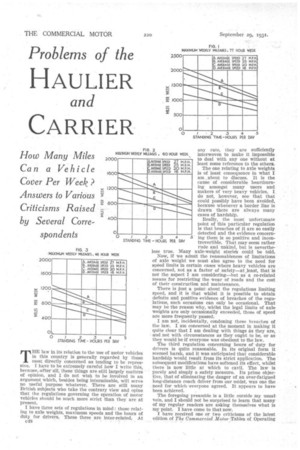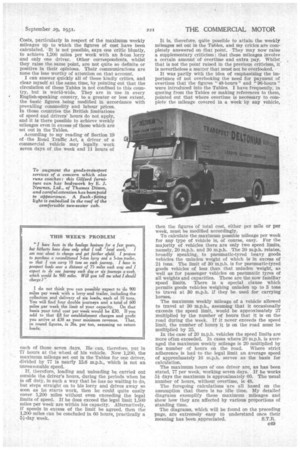Problems of the
Page 70

Page 71

If you've noticed an error in this article please click here to report it so we can fix it.
HAULIER
and
CARRIER
How Many Miles Can a Vehicle Cover Per Week? Answers to Various Criticisms Raised by Several Corre spondents
TTIE law in its relation to the use of motor vehicles in this country is generally regarded by those most directly concerned as tending to be repressive. I have to be extremely careful how I write this, because,-after all, these things are still largely matters of opinion, and I do not wish to be involved in an argument which, besides being interminable, will serve no useful purpose whatever. There are still many British subjects who take the contrary view and opine that the regulations governing the operation of motor vehicles should be much more strict than they are at present.
I have three sets of regulations in mind : those relating to axle weights, maximum speeds and the hours of duty for drivers. These three are inter-related. At c48 any rate, they are sufficiently interwoven to make it impossible to deal with any one without at least some reference to the others.
. The one relating to axle weights is of least consequence in what I am , about to discuss. It is the catise of considerable heartburnlag amongst many users and makers of very heavy vehicles. I do not, however, see that that could possibly have been avoided, because whenever a border line 'is drawn there are always many cases of hardship.
Really, the most unfortunate point of this particular regulation is that breaches of it are so easily detected and the evidence concerning them is so positive and incon trovertible. That may seem rather rude and unkind, but is nevertheless true. Many axle-weight stories could be told. Now, if we admit the reasonableness of limitations of axle weight we must also agree to the need for speed limits in certain cases where heavy vehicles are concerned, not as a factor of safety—at ,least, that is not the aspect I am considering—but as a co-related means for restricting the wear of roads and the cost of their construction and maintenance.
There is just a pointi about the regulations limiting speed, and it is that whilst it is possible to obtain
definite and positive evidence of breaches of the regulations, such occasions can only be occasional. That may be the reason why, whilst the legal limits of axle weights are only occasionally exceeded, those of speed are more frequently passed.
I am not, incidentally, condoning these bieaches of the law. I am concerned at the moment in making it
quite clear that I am dealing with things as they are, and not with circumstances as they ought to be, or as they would be if everyone was obedient to the law.
The third regulation concerning hours of duty for drivers is quite reasonable. In its original form it seemed harsh, and it was anticipated that considerable hardship would result from its strict application. The subsequent modifications have softened its effect, whilst there is now little at which to cavil. The law is purOy and simply a safety measure. Its prime objective, that of eliminating the danger of an over-fatigued long-distance coach driver from our midst, was one the need for which -everyone agreed. It appears to have been achieved.
The foregoing preamble is a little outside my usual vein, and I should not be surprised to learn that many of my regular readers are asking themselves what is my point. I have come to that now.
have received one or two criticisms of the latest edition of The Commercial Motor Tables of Operating Costs, particularly in respect of the maximum weekly mileages up to which the figures of cost have been calculated. -It is not possible, says one critic bluntly, to achieve 1,200 miles per week with an 8-ton lorry and only one driver. Other correspondents, whilst they raise the same point, are not quite so definite or positive in their opinions. Their communications are none the less worthy of attention on that account.
I can answer quickly all of these kindly critics, and clear myself at the same, time, by pointing out that the circulation of these Tables is not confined to this country, but is world-wide. They are in use in every English-speaking country, to a greater or less extent, the basic figures being modified in accordance with prevailing commodity and labour prices. In those countries the British limitations of speed and drivers' hours do not apply, and it is there possible to achieve weekly mileages even in excess of those which are set out in the Tables.
According to my reading of Section 19 of the Road Traffic Act, a driver of a commercial vehicle may legally work seven days of the week and 11 hours of each of those seven days. He can, therefore, put in 77 hours at the wheel of his vehicle. Now 1,200, the maximum mileage set out in the Tables for one driver, divided by 77 is nearly 156 m.p.h., which is not an unreasonable speed.
If, therefore, loading and unloading be carried out outside the driver's hours, during the periods when he is off duty, in such a way that he has no waiting to do, but steps straight on to his lorry and drives away so soon as he starts work, then he could quite easily cover 1,200 miles without even exceeding the legal limits of speed. If he does exceed the legal limit 1,500 miles per week are within his capacity. Alternatively, if speeds in excess of the limit he agreed, then the 1,200 miles can be concluded in 60 hours, practically a 5-1-day week.
It is, therefore, quite possible to attain the weekly mileages set out in the Tables, and my critics are completely answered on that point. • They may now raise a supplementary criticism : that these mileages involve a certain amount of overtime and extra pay. Whilst that is not the point raised in the previous criticism, it is nevertheless a matter that must not be overlooked.
It was partly with the idea of emphasizing the importance of not overlooking the need for payment of overtime that the figures " 48-hours " and " 96-hours " were introduced into the Tables. I have frequently, in quoting from the Tables or making references to them, pointed out that where overtime is necessary to complete the mileage covered in a week by any vehicle,
then the figures of total cost, either per mile or per week, must be modified accordingly;
To calculate the maximum possible mileage per week for any type of vehicle is, of course, easy. For the majority of vehicles there are only two speed limits, namely, 20 mph. and 30 m.p.h. The 20 m.p.h. relates, broadly speaking, to pneumatic-tyred heavy goods vehicles the unladen weight of which is in excess of 21 tons. The limit of 30 m.p.h. is for pneumatic-tyred goods vehicles of less than that unladen weight, as well as for passenger vehicles on pneumatic tyres of all weights and capacities. These are the now familiar speed limits. There is a special clause which permits goods vehicles weighing unladen up to 3 tons to travel at 30 m.p.h. if they be used for carrying horses.
The maximum weekly mileage of a vehicle allowed to travel at 30 m.p.h., assuming that it occasionally exceeds the speed limit, would be approximately 27 multiplied by the number of hours that it is on the road during the week. If it never exceeds the speed limit, the number of hours it is on the road must be multiplied by 25.
In the case of 20 m.p.h. vehicles the speed limits are more often exceeded. In cases where 20 m.p.h. is averaged the maximum weekly mileage is 20 multiplied by the number of hours on the road. Where strict adherence is had to the legal limit an average speed of approximately 16 m.p.h. serves as the basis for calculation.
The maximum hours of one driver are, as has been stated, 77 per week, working seven days. If he works 51 days the maximum is approximately 60. The usual number of hours, without overtime, is 48.
The foregoing calculations are all based on the assumption that there is no idle time. My detailed diagrams exemplify these maximum mileages and show how they are affected by various proportions of standing time.
The diagrams, which will be found on the preceding page, are extremely easy to understand once their meaning has been appreciated. S.T.R.












































































































